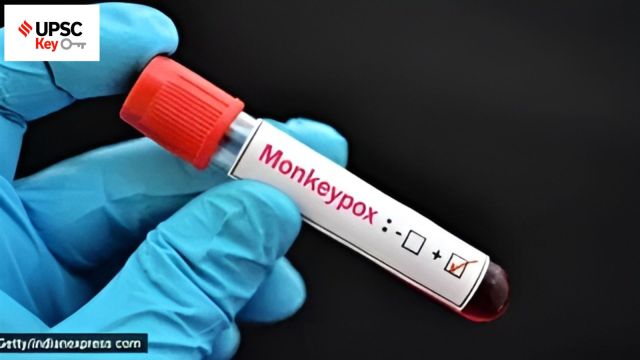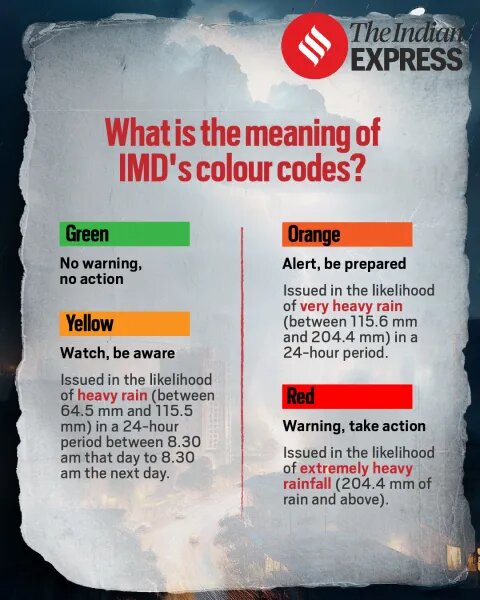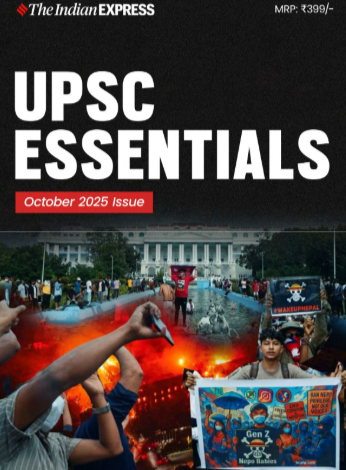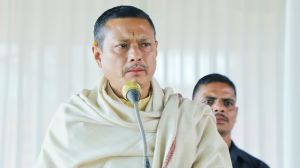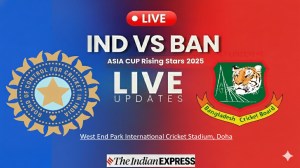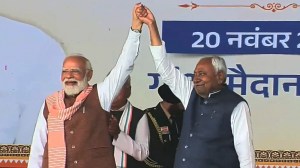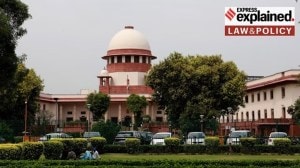🚨 The Indian Express UPSC Essentials brings to you the August edition of its monthly magazine. Click Here to read. Share your views and suggestions in the comment box or at manas.srivastava@indianexpress.com🚨
Govt & Politics
UPSC Syllabus:
Preliminary Examination: Current events of national and international importance
Mains Examination: GS-II: Bilateral, regional and global groupings and agreements involving India and/or affecting India’s interests.
What’s the ongoing story- Proposing the creation of a human-centric “Global Development Compact”, PM Narendra Modi Saturday called the Voice of the Global South Summit a platform to “give voice to the needs and aspirations of those who have been unheard till now”.
Prerequisites:
— What do you understand by the term “Global South”?
— Read about the Voice of the Global South Summit.
Key takeaways:
— PM Modi, delivering his opening remarks during the virtually held India-hosted third summit, said, “global governance and financial institutions formed in the last century have been unable to fight the challenges of this century.”
— Announcing the ‘Compact’, PM Modi said needy countries will not be burdened with debt in the name of development finance. The foundation of the ‘Compact’, he said, will be based on India’s development journey and experiences of development partnership.”
Story continues below this ad
— “Under this Compact we will focus on trade for development, capacity building for sustainable growth, technology sharing, project-specific concessional finance and grants. To strengthen trade promotion activities, India will start a special fund of USD 2.5 million,” he said, adding that a fund of USD 1 million will be provided for this.
— Urging that steps be taken to reduce the gap between the Global North and the Global South, he said the Summit of the Future in the UN next month can become an “important milestone for all this” and emphasised that the Global South need to unit, stand together in one voice, become each other’s strength and learn from each other’s experience.
For Your Information:
— In the simplest sense, Global South refers to the countries of Asia, Africa, Latin America, and Oceania. Most of these countries, where 88 per cent of the world population lives, experienced colonial rule and historically lagged in achieving substantial levels of industrialisation.
— The developed countries of North America and Europe, on the other hand, are often referred to as the Global North. These countries have a history of pursuing imperial policies.
Story continues below this ad
— According to the United Nations Conference on Trade and Development, Global South countries typically exhibit lower levels of development, higher income inequality, rapid population growth, agrarian-dominant economies, lower quality of life, shorter life expectancy, and significant external dependence.
— The term Global South, thus, denotes political, geopolitical, and economic similarities between nations. Hence, it should not be conflated with strict geographical connotations. For instance, most Asian countries fall under the Global South. Yet, countries such as Israel, South Korea, and Japan are considered part of the Global North because of their higher levels of development.
Points to Ponder:
— What is the Global Digital Public Infrastructure (DPI) Repository?
— Evaluate the significance and emergence of the term Global South.
— What are the challenges for India as a leader in the Global South?
Story continues below this ad
— What is the significance of Africa for India in its vision for the Global South?
Post Read Question:
The rise of the Global South as an economic and political force has brought focus on the changing global order. Comment.
Other Important Articles Covering the same topic:
20th-century global institutions unable to face present challenges, say PM Modi, Jaishankar, urge Global South to unite
UPSC Syllabus:
Story continues below this ad
Preliminary Examination: Current events of national importance, polity and governance
Mains Examination: GS-II: Constitution, Polity and Governance
What’s the ongoing story- The Union Service Public Commission (UPSC) Saturday sought applications for lateral entry from private sector, state/UT government and PSU employees for 45 posts of Joint Secretary, Director and Deputy Secretary across 24 Central ministries which will be filled on contract basis by September 17.
Prerequisites:
— What is ‘lateral entry’ into the bureaucracy?
— Read the constitutional provisions related to the UPSC.
Key takeaways:
— Appointment to the posts will be on a contract basis for a period of three years, extendable to five years depending upon performance, and central government employees are not eligible for the posts, the advertisement said.
— The lateral recruitment — referred to as appointment of private sector specialists in government departments — began in 2018 after NITI Aayog and the Sectoral Group of Secretaries on Governance recommended it in its report in 2017.
Story continues below this ad
— “Keeping in view their specialised knowledge and expertise in the domain area, lateral recruitment at the level of Joint Secretary, Director and Deputy Secretary in Government of India, has been undertaken to appoint persons for specific assignments. So far 63 appointments have been made through lateral entry at the level of Joint Secretary, Director and Deputy Secretary during the last 5 years. Presently 57 officers are in positions in Ministries/ Departments,” Jitendra Singh, MoS for Personnel, had told the Rajya Sabha on August 8.
For Your Information:
— In 2019, Minister of State for the Department of Personnel and Training (DoPT) Jitendra Singh told the Rajya Sabha that “lateral recruitment is aimed at achieving the twin objectives of bringing in fresh talent as well as augment the availability of manpower”.
— Basically, the idea behind lateral recruitment is for the government to tap into individuals’ domain expertise and specialised know-how, regardless of whether they are career bureaucrats or not.
Points to Ponder:
— What are the benefits of lateral entry into the bureaucracy?
— What is the criticism of lateral entry recruitment?
Story continues below this ad
— How have lateral entries been kept out of the ambit of reservation?
— What are the major administrative reforms recommended by the committees?
Post Read Question:
How is lateral entry into the bureaucracy a challenging administrative reform?
Other Important Articles Covering the same topic:
UPSC issues ad for lateral entry into bureaucracy: What is the policy, why it has no reservation provision
Story continues below this ad
UPSC Syllabus:
Preliminary Examination: Current events of national and international importance
Mains Examination: GS-II: Constitution, Polity, Government policies and interventions
What’s the ongoing story- Days after Prime Minister Narendra Modi made a strong pitch for the Uniform Civil Code (UCC) during his Independence Day address, saying it’s time the country moves towards a civil code that is “secular” and not “communal” and “discriminatory” as the existing one, the All India Muslim Personal Law Board (AIMPLB) Saturday said Modi’s call is “highly objectionable” and “unacceptable.”
Prerequisites:
— What is the Uniform Civil Code (UCC)?
— Read the constitutional provisions related to religious freedom and UCC.
— Know about the personal laws in India.
— What was the Constituent Assembly debate regarding the adoption of UCC?
Key takeaways:
— “The Board in no uncertain terms makes it clear that it is unacceptable to Muslims as they will never compromise with Sharia Law (Muslim Personal Law),” the statement read, adding that its spokesperson SQR Ilyas — in a press statement — has expressed “shock at the PM’s announcement to term Personal Laws based on religion, as communal ones and to further replace them with a Secular Civil Code.”
— From the ramparts of Red Fort on Thursday, PM Modi had said, “… I say it is the need of the hour that there should be a Secular Civil Code in the country. We have spent 75 years under the Communal Civil Code. Now we will have to move towards a Secular Civil Code. Only then we will get relief from the discrimination happening on the basis of religion in the country…”
For Your Information:
— A Uniform Civil Code would provide for one law for the entire country, applicable to all religious communities, in their personal matters such as marriage, divorce, inheritance, adoption, etc.
— The framers of the Constitution recognised the need for uniform personal laws, but placed it in the Directive Principles of State Policy. Article 44 of the Constitution says that “the State shall endeavour to secure for the citizens a uniform civil code throughout the territory of India”.
— Article 44 is among the Directive Principles of State Policy. Directive Principles are not enforceable by court, but are supposed to inform and guide governance.
Points to Ponder:
— What are the arguments for and against the implementation of UCC?
— Analyse the Conflict Between Fundamental Rights and Directive Principles.
— What are the challenges associated with the implementation of UCC?
— What has the 22nd Law Commission said about UCC?
Post Read Question:
Prelims
(1) Consider the following provisions under the Directive Principles of State Policy as enshrined in the Constitution of India: (UPSC CSE 2012)
1. Securing for citizens of India a uniform civil code
2. Organising village Panchayats
3. Promoting cottage industries in rural areas
4. Securing for all the workers reasonable leisure and cultural opportunities
Which of the above are the Gandhian Principles that are reflected in the Directive Principles of State Policy?
(a) 1, 2 and 4 only
(b) 2 and 3 only
(c) 1, 3 and 4 only
(d) 1, 2, 3 and 4
Mains
Discuss the possible factors that inhibit India from enacting for its citizens a uniform civil code as provided for in the Directive Principles of State Policy. (UPSC CSE 2015)
Other Important Articles Covering the same topic:
PM’s UCC pitch: Time for secular civil code, lived 75 yrs with communal one
The 360° UPSC Debate: Is Uniform Civil Code ‘unnecessary and undesirable’ or ‘justice for all communities’
Express Network
UPSC Syllabus:
Preliminary Examination: Current events of national and international importance
Mains Examination: GS-II, III: Government policies and interventions, Science and Technology
What’s the ongoing story- Health units at airports, seaports, and ground crossings will be sensitised, 32 laboratories will be ready along with the health facilities for detecting, isolating, and managing cases of Mpox, health ministry said on Saturday.
Prerequisites:
— What do you understand by the term “pandemic”?
— What is Mpox?
— Know about the criteria of the WHO to declare any disease a public health emergency of international concern.
— Read about the WHO.
Key takeaways:
— A joint monitoring group under the chairmanship of director general of health services Dr Atul Goel said that the risk of a large outbreak in the country remains low but there was a possibility of the infection being imported by travellers.
— Since the beginning of 2022, India has recorded 30 cases of Mpox — previously referred to as Monkey Pox — with the last case being recorded in March this year. No cases of Mpox have been recorded in India during the current outbreak, the statement said.
— Earlier this week, the World Health Organisation sounded its highest level of alarm for Mpox again — the outbreak between July 2022 and May 2023 was also declared Public Health Emergency of International Concern. While the infections were largely caused by the less deadly clade II Mpox during the previous outbreak, the current concern stems from a faster spreading and deadlier variety.
— The current outbreak is largely caused by clade I Mpox, which is now transmitted sexually. While clade I infection is known to be transmitted through close contacts or coming in contact with infected droplets on surfaces, transmission through sexual contact has not been reported earlier.
For Your Information:
— Mpox, a viral disease previously known as monkeypox, has recently garnered significant global attention due to its increasing spread and the emergence of new variants. It is a self-limiting disease but can lead to death, especially among children and those with weak immune systems.
— The World Health Organization (WHO) classified mpox as a global public health emergency. This comes after a surge in cases in the Democratic Republic of Congo, with the virus spreading to neighbouring countries.
— Mpox was first discovered in humans in 1970 in the Democratic Republic of the Congo (DRC). Over the decades, mpox cases have arisen intermittently in many African countries, with occasional outbreaks in non-African regions as a result of international travel and the importation of infected animals.
— The vaccines developed for smallpox are up to 80 per cent effective against mpox.
Points to Ponder:
— What is the difference between endemic, pandemic and epidemic?
— What is India’s preparedness against the pandemic?
— What is the role of WHO in providing global health security?
Post Read Question:
(2) With reference to the Mpox, consider the following statements:
1. It was first discovered in humans in Nigeria.
2. It is not transmitted from animals to humans.
3. The vaccines developed for smallpox are up to 80% effective against mpox.
4. The World Health Organization classified mpox as a global public health emergency.
How many of the statements given above are correct?
(a) Only one
(b) Only two
(c) Only three
(d) All four
Other Important Articles Covering the same topic:
WHO declares Mpox a global health emergency again
UPSC Syllabus:
Preliminary Examination: Indian geography
Mains Examination: GS-I, GS-III: Important Geophysical phenomena, Science and Technology
What’s the ongoing story- When Mumbai woke up on July 8, it was taken by surprise – large parts of the city were inundated in the 200 mm overnight rains. But nothing about the India Meteorological Department’s (IMD) prediction, issued the previous day, had prepared the city for the downpour. The agency had issued a yellow alert, which meant the city was expected to receive up to 115 mm of rainfall in 24 hours. But the metropolis ended up getting 267 mm rain in the period.
Prerequisites:
— Read about the Indian Meteorological Department (IMD)
— What are Doppler Weather Radars?
Key takeaways:
— This wasn’t a rare miss by the IMD. Data reviewed by The Indian Express shows that the agency, despite being equipped with some of the most advanced instruments, issued inaccurate district forecasts for Mumbai on at least 13 days in July, of which, on eight days, the forecast warnings were off by more than 25 per cent.
— Mumbai is home to two doppler weather radars, one of the most sophisticated instruments in modern meteorology….Through the regular scans, the radars help in providing localised forecasts depending on cloud developments and other factors.
— IMD acknowledges that its forecasts, particularly the city-specific forecasts, have not been perfect, but says its accuracy levels are improving.

— “IMD’s forecasting systems have improved by 40-50 per cent in the last decade compared to previous years. But it needs to be understood that weather forecasting is a nonlinear science, which means that unlike other sciences, weather has greater unpredictability,” said Mrutyunjay Mohapatra, Director General of Meteorology.
— In the last one decade, IMD has seen a significant increase in its observational network. It operates more than 400 weather stations, besides having over 1,000 automatic weather stations and 1,300 automatic rain gauges. That has enabled IMD to provide much better forecasts. But the weather systems have also become much more unpredictable in the last few years. This is particularly true of extreme weather events, exposing the inadequacies of the IMD.
Points to Ponder:
— What are the weather forecasting methods used by the IMD?
— What challenges are faced by the IMD in providing accurate weather forecasts?
— What steps have been taken by the government concerning Meteorology in India?
Post Read Question:
Prelims
(3) With reference to ‘Indian Ocean Dipole (IOD)’ sometimes mentioned in the news while forecasting Indian monsoon, which of the following statements is/are correct? (UPSC CSE 2017)
1. IOD phenomenon is characterised by a difference in sea surface temperature between tropical Western Indian Ocean and tropical Eastern Pacific Ocean.
2. An IOD phenomenon can influence an El Nino’s impact on the monsoon.
Select the correct answer using the code given below:
(a) 1 only
(b) 2 only
(c) Both 1 and 2
(d) Neither 1 nor 2
Mains
Discuss the meaning of colour-coded weather warnings for cyclone prone areas given by India Meteorological Department. (UPSC CSE 2022)
Front Page
UPSC Syllabus:
Preliminary Examination: Indian Polity and Governance
Mains Examination: GS-II: Constitution, Indian Polity and Governance, Various Constitutional posts, powers, functions.
What’s the ongoing story- Karnataka Governor Thawarchand Gehlot on Saturday accorded sanction for prosecution against Chief Minister Siddaramaiah and allowed three private complainants to file cases in court seeking a probe against him over allotment of 14 housing sites in Mysuru to his wife in 2021 (when the BJP was in power) in exchange for 3.16 acres of land acquired from her by Mysuru authorities.
Prerequisites:
— Constitutional provisions related to the Governor and State Government.
— Office of Governor-know the historical background
— Know about the Prevention of Corruption Act, 1988 and Bharatiya Nagarik Suraksha Sanhita, 2023
Key takeaways:
— “I hereby accord sanction against Chief Minister Sri Siddaramaiah under Section 17A of the Prevention of Corruption Act, 1988, and Section 218 of the Bharatiya Nagarik Suraksha Sanhita, 2023, for the commission of the alleged offences as mentioned in the petitions,” Gehlot said in a August 16 communication released Saturday.
— The Karnataka government is expected to challenge the Governor’s decision. “Cabinet has decided that the sanction for prosecution has no constitutional backing. We are going to challenge… It has strongly condemned the Governor for working as a representative of the Central government,” Chief Minister Siddaramaiah said.
For Your Information:
— Article 153 of the Constitution says “There shall be a Governor for each State.” A few years after the commencement of the Constitution, an amendment in 1956 laid down that “nothing in this article shall prevent the appointment of the same person as Governor for two or more States”.
— The landmark case of Shamsher Singh v State of Punjab, decided in 1974 by a seven-judge Constitution bench of the Supreme Court, established that a Governor is required to exercise their formal constitutional powers solely upon and in accordance with the aid and advice of their ministers, except in limited well-known exceptional circumstances.
Points to Ponder:
— What are the powers and functions of the Governor?
— What is the relationship between the Governor and the state government?
— How does the role of the governor differ from that of the President in terms of their constitutional positions?
— What are the recommendations made by various committees with regard to office of the Governor?
(Thought Process: Administrative Reforms Commission of 1968, Sarkaria Commission of 1988, Venkatachaliah Commission of 2022, observations made by the Supreme Court, and more.)
— What is the Supreme Court’s stand on office of Governor?
Post Read Question:
Prelims
(4) Which of the following are the discretionary powers given to the Governor of a State? (UPSC CSE 2014)
1. Sending a report to the President of India for imposing the President’s rule
2. Appointing the Ministers
3. Reserving certain bills passed by the State Legislature for consideration of the President of India
4. Making the rules to conduct the business of the State Government
Select the correct answer using the code given below:
(a) 1 and 2 only
(b) 1 and 3 only
(c) 2, 3 and 4 only
(d) 1, 2, 3 and 4
Mains
Discuss the essential conditions for exercise of the legislative powers by the Governor. Discuss the legality of re-promulgation of ordinances by the Governor without placing them before the Legislature. (UPSC CSE 2022)
Other Important Articles Covering the same topic:
What explains the frequent disagreements between state governments and Governors?
Economy
UPSC Syllabus:
Preliminary Examination: Economic development
Mains Examination: GS-III: Indian economy
What’s the ongoing story- In the financial year 2023-24, India imported electronic components worth over $12 billion from China and $6 billion from Hong Kong, with the two accounting for more than half of total such imports to India – suggesting that the country’s growing footprint in electronics manufacturing may not yet be translating into reduced reliance on Beijing.
Prerequisites:
— What is the objective of the ‘Make in India’ initiative launched by the Government of India?
— What is the status of India-China trade?
— What are the top 5 products imported and exported by India?
Key takeaways:
— In the last five years, electronics imports from China and Hong Kong have far outnumbered imports from other major manufacturing hubs like South Korea, Japan, Taiwan, and all ASEAN countries, combined.
— In fact, in 2023-24, electronic components imports stood at $34.4 billion, making them the fifth largest commodity to be imported to India, after crude, gold, petroleum products, and coal, according to data sourced from the Ministry of Commerce. These components constitute key building blocks for the finished electronics products that are currently being assembled in India – from smartphones to televisions.
— The overall picture of India’s reliance on Chinese supply of electronic components becomes clearer when compared to the imports from some other electronics hubs – such as South Korea, Japan, Taiwan and ASEAN countries which include the likes of Vietnam and Malaysia.
— In the last five years, barring 2022-23, the quantum of import of electronic components from China alone has outnumbered such imports from South Korea, Japan, Taiwan and all ASEAN countries, combined. Put together, imports from China and Hong Kong have been more than the other countries in each of the last five years. This is despite India having free trade agreements with ASEAN countries, Japan and South Korea.
— India is seemingly warming up to the idea of letting more Chinese entities set up bases in the country in partnership with domestic firms, as part of joint ventures. The Economic Survey 2023-24 said that India should reduce the import of Chinese products while maintaining investments from Beijing.
Points to Ponder:
— What is the significance of electronic manufacturing in India’s economic growth?
— What measures have been taken by the government to boost the domestic manufacturing of electronic products?
— What are the challenges faced by India in reducing its reliance on Chinese imports?
— What steps should be taken to boost domestic production of electronic components?
Post Read Question:
(5) What is/are the recent policy initiative(s) of the Government of India to promote the growth of manufacturing sector? ( UPSC CSE 2012)
1. Setting up of National Investment and Manufacturing Zones
2. Providing the benefit of ‘single window clearance’
3. Establishing the Technology Acquisition and Development Fund
Select the correct answer using the codes given below:
(a) 1 only
(b) 2 and 3 only
(c) 1 and 3 only
(d) 1, 2 and 3

